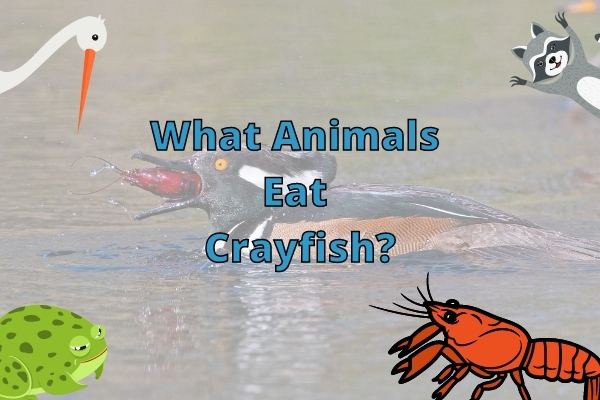Crayfish (crawfish or crawdads) are small, freshwater crustaceans that are related to lobsters and crabs. They are a popular food source in many parts of the world, and they are also kept as pets.
Crayfish have many predators, including fish, amphibians, reptiles, birds, and mammals. Some of the most common land predators of crayfish include Herons, Mergansers, Kingfishers, Muskrats, Crayfish snakes, Turtles, and Otters.
Because crayfish have a thick protective exoskeleton surrounding their soft body, they are not always easy to eat.
To break through the shell of a shellfish, a predator needs as certain size and strength in their jaws or very sophisticated motor skills that allows them to peel off the shell of the crayfish before eating it!
From the infographic above you can see all of the animals that most often eat crayfish. In fact, fish are the most abundant and common predators of crayfish and some of these fish will eat more than 95% of their diet as crayfish!
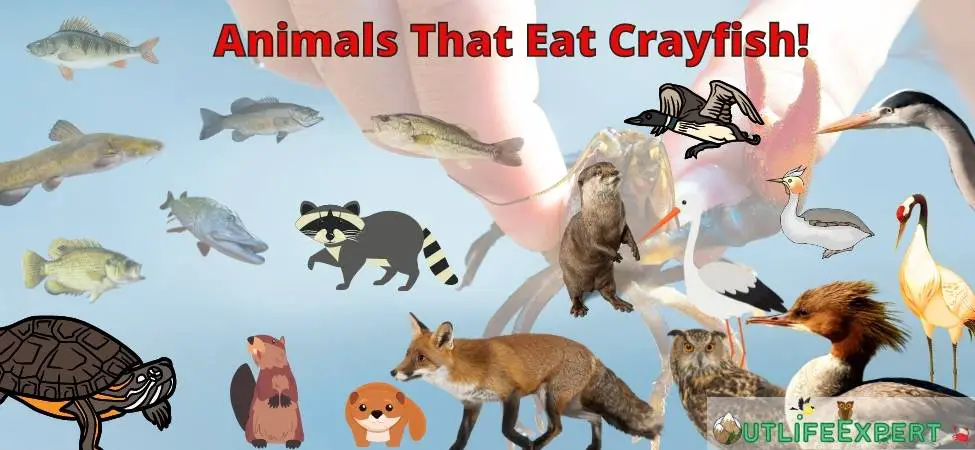
I have written a whole article about fish that eat crayfish, so I will not cover the topic here.
But here I will get into all the other types of animals that eat crayfish. Birds are on top of the list!
Contents
Top 10 Birds That Eat Crayfish:
Top Mammals That Eat Crayfish Are:
- Raccoons
- Foxes
- Muskrats
- Otters
- Mink
- Shrews
- Rats
Other Animals that Eat Crayfish:
Below are some of the other types of animals including reptiles, amphibians and parasites.
- Crayfish Snake
- Queen Snake
- Eastern painted turtles
- Bullfrogs
- Parasites
- Large freshwater fish (I have dedicated another post to these)
Introduction To Crayfish!
Crayfish live in freshwater habitats. They can live in ponds, rivers, or lakes. They can survive in fresh or salty water, but they prefer fresh water. Crayfish are freshwater crustaceans that like to eat plants and algae.
Crayfish eat plants and algae, but they also eat bacteria, protozoa, and nematodes. Crayfish eat many different types of plants, but they find most of their food in the plant particles that float in the water – especially as juveniles. This is called phytoplankton.
Crayfish eat many types of plankton, including diatoms, green algae, and blue-green algae.
Crayfish eat a lot of plants, but they are also an important predator in freshwater habitats. They eat many types of fish eggs and spawn, and they eat some invertebrates like snails and insects as well. So no wonder fish are so eager to get rid of them…
Crayfish have a long, sharp claw on each of their two pairs of legs. This claw is used to grab their prey and to fight competitors for mating. Interestingly, if these pinchers fall off, they will regrow within a year or so!
Birds That Eat Crayfish
Birds, especially those that are large and associated with freshwater, are also common predators of crayfish.
Interestingly, most birds have developed quite a sophisticated technique to eat crayfish where they bite of both of their pinchers before swallowing the crayfish (almost) whole!
The birds that eat most crayfish are those that forage around the edges of ponds, rivers or lakes.
These include herons, storks and egrets, but also some kingfishers like the Belted Kingfisher that has specialized in catching crayfish despite its relatively small size.
Some of these birds can easily live on crayfish as the main part of their diet. Others like owls or seagulls, hawks and other birds of prey are more opportunistic crayfish feeders that are just going to eat them when they happen to find them, but they also eat many other things.
I will go through some of the most interesting crayfish eating birds in the following!
Owls – do they really eat crayfish?
Owls are amazing and interesting animals. They are highly intelligent, able to solve problems and learn very quickly. They are also very adaptable. They can adapt to a variety of environments, and can even survive in the desert!
A prime example of a crayfish eating owl is the Barred Owl that lives in forests of Alaska, South Canada, South-eastern Alaska, British Columbia and Washington.
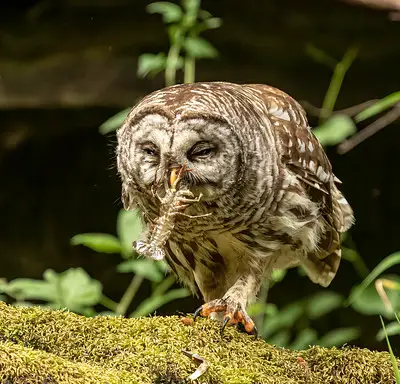
These owls are mostly known for eating mice, squirrels, and frogs, but by eating crayfish they are able to survive on much less land by just focusing on the shallow parts of a creek where the crayfish pass by!
Some barred owls even eat enough of the small red crayfish that their feathers gain a pink’ish hue, just like that of shrimp-eating flamingos!
Kingfishers
Kingfishers are fishing birds that live near freshwaters and especially the Belted Kingfisher is known to fish for crayfish.
The Belted kingfishers live in freshwater marshes, riverine wetlands, lake shores, and ponds. The most common in North America, in the United States the range is along the Atlantic coastal plain from Nova Scotia to the Gulf of Mexico, including in the Great Lakes.
In Canada the range extends from southern Alaska to northern British Columbia.
Belted kingfishers are fairly specialized, eating primarily fish, and, in some areas, crayfish. (They have very specialized hunting technique.
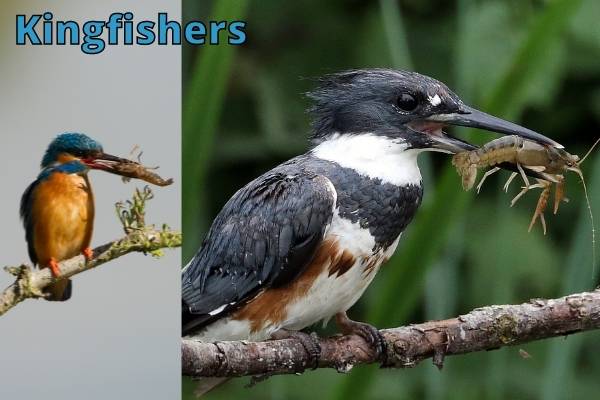
They wait for their prey to be almost motionless in the water, and then pounce on them from the air!) In their wintering grounds, they often are found in lakes and rivers that are ice-free.
Most kingfishers eat fish, larger insects, and even tadpoles.
Not every individual makes all of those options are part of their diet. Some, primarily in the north, do Kingfishers eat crayfish, but don’t go out of their way to eat them.
The Hooded Merganser
Mergansers are a genus of ducks that are most often found in fresh or saltwater lakes and ponds. Most species are migratory, but some species are year-round residents. The male is more colorful than the female, and the female is a drab gray-brown.
Mergansers are typically fish-eaters, but they also eat crustaceans, insects, and worms. Their diet can change seasonally, and some species are opportunistic crayfish feeders.
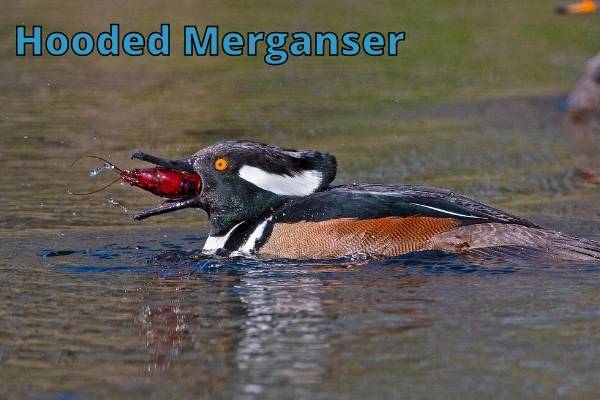
Especially the hooded mergansers enjoy preying on crayfish as a large part of their diet.
Hooded mergansers prefer freshwater lakes and ponds where they can hunt for crayfish, but winter, they do not usually eat crayfish as they are most often found in open bays or estuaries where crayfish are absent.
Do Herons Eat Crayfish?
Yes! Blue, Green and Gray herons are some of the most adaptable birds around. They eat fish, worms, crayfish, insects, and even crabs and frogs!
Just like the green heron I showed you in the video, other herons often fish at the edge of freshwater where they may spot a crayfish.

The same is the case for the Gray Heron, which also gladly eats crayfish for dinner!
They are, however, not as well trained in preparing them for easy ingesting as the Green Heron is.
Egrets
Egrets live in wetlands, swamps, ponds and lakes. They spend most of their time standing still, waiting for prey to come by.
They are sometimes called “little herons” (because they superficially resemble the much larger great heron), and are identified by their unique long, narrow, pointed bill.

Their long, slender, wedge-shaped bills are excellent at prying open crayfish but also many other animals such as water snakes, frogs, large tadpoles, crabs, snails, small fish, and lizards. They are also known to eat insects and even rodents.
Red Shouldered Hawk
Red shouldered hawks are birds of prey that are named after their red and brown feathers. They typically live in forests and eat small mammals, reptiles, and birds. However, they will also eat crayfish if they are available.
Crayfish can make up a significant part of the red shouldered hawk’s diet in some areas and they get some of their red nuances from the high amount of crayfish pigment in their diet!
These hawks will wait near streams or other bodies of water where crayfish are present. When they see one, they will swoop down and catch it with their talons.
They will then take the crayfish back to their perch to eat it. Red shouldered hawks have been known to eat up to 12 crayfish per day!
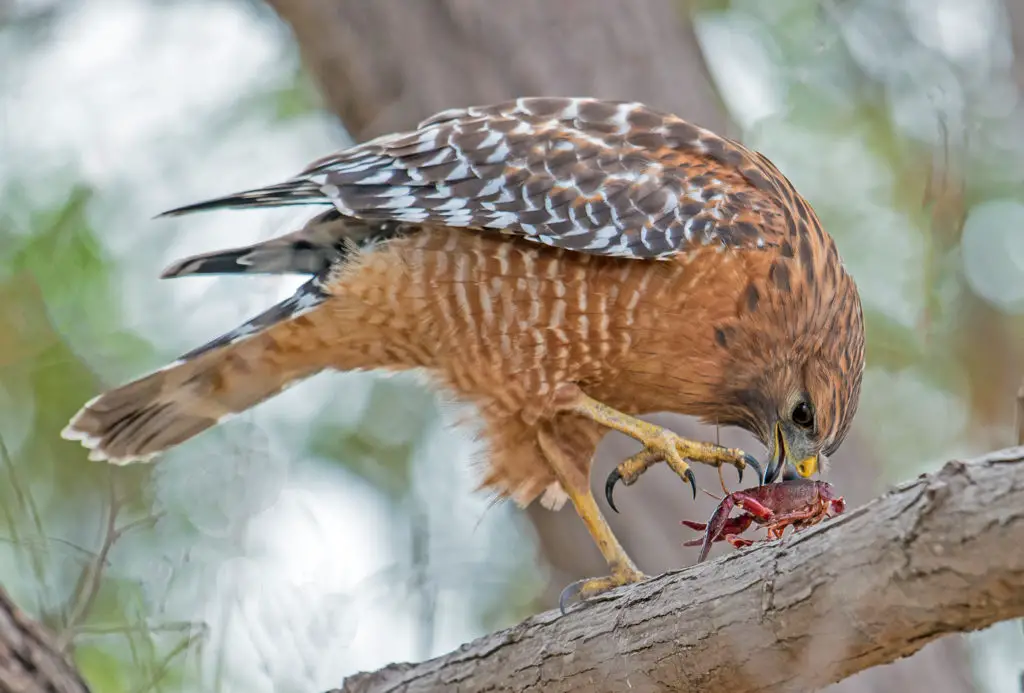
Hawks eat much more than crayfish though, and I have written more about their diet here!
Loons
The loon is a large bird that can be found in North America. It is easily recognizable by its black head and white body.
Loons are very good swimmers (but are terrible at walking!) and can even dive under the water to catch fish!
The loon’s diet consists mostly of fish, but it will also eat crayfish, frogs, snakes, and insects.

To find its food, the loon uses its sharp eyesight to look for movement in the water. It will then dive down and catch the fish with its long beak.
Read more about loons in my recent post.
Grebes
Grebes are a type of waterbird that can be found all over the world. There are 22 different species of grebe, and they are all proficient swimmers!
Grebes eat a variety of small aquatic creatures such as fish, insects, and crustaceans. But, they are especially fond of crayfish!

To catch their prey, grebes will dive underwater and swim after their quarry. Once they catch up to their meal, they will use their sharp beaks to snag it before swiftly swallowing it whole (not unlike the Hooded Merganser photo above…!).
Loon and Grebes are very interesting birds and while it is fun to watch them swim and dive in the water, but even more fun to watch them (try to) walk!
In fact, I recently wrote about how loons and grebes are so adapted to life in the water and in the air that they are the only birds that have lost their ability to walk on land!
What other animals eat crayfish?
Many other animals, including mammals and reptiles that live near freshwater will sometimes feed on crayfish. I have gone into and described each of the more well-known crayfish predators below.
The Crayfish and Queen Snakes
Crayfish snakes are a type of water snake that can be found in freshwater environments across North America.
They get their name from their diet, which consists of, you guessed it, crayfish! These snakes are excellent swimmers and use their long, slender bodies to glide through the water in search of their prey.

Crayfish snakes will often eat their prey whole, shell and all, like most snakes consumer their food!
Another very similar snake that feed on crayfish is the Queen Snake.
The queen snake is a non venomous colubrid snake found in North America. It is a medium-sized snake, reaching lengths of up to 3 feet. Queen snakes are typically grey or brown in color, with dark crossbands on their body.
The queen snake and the crayfish snakes are very closely related and they both feed exclusively on crayfish. A crucial difference though, is that the queen snake (given its finer heritage) will only eat soft crayfish that have just undergone molting!
Indeed the queen snake can actually smell the when a crayfish has just molted as it gives of certain chemicals to the water that the snake senses with its tongue!
Foxes
The fox is a cunning and wily creature. It is a member of the canine family, but is more closely related to wolves than dogs. Foxes are found all over the world, in a variety of climates and habitats.
Foxes are carnivore animals, which means that they primarily eat animals. Their diet consists of small mammals such as rabbits, rodents and birds, as well as some insects – but also seafood!
One of the most interesting things about foxes is their ability to adapt to their environment and find food that other animals wouldn’t think to look for. For example, in areas where there are a lot of crayfish, foxes will include them in their diet!
Crayfish are not easy to catch, so it takes a lot of skill for a fox to be able to snag one. But once they’ve got the hang of it, they can really feast on these little creatures!
Raccoons
Although racoons will basically eat anything, crayfish are one of the best favourite foods of raccoons. When the climate is warm, the feeding behaviour of raccoon changes to include more shellfish like crabs and crayfish.
The raccoons tend to seek for more crawfish than any other food competitors, because the carnivorous diet of raccoon provides high calorie keeping it warm.
Otters
Otters are one of the most playful animals in the world. They are also very intelligent and have a strong sense of family. Otters live in rivers, streams, lakes and marshes all over the world.
One of their favorite things to eat is crayfish! Otters will often play with their food before eating it.
They will sometimes throw the crayfish in the air, catch it, roll around with it, almost juggling it, seemingly for fun!
Otters use their sensitive whiskers to help them find crayfish hiding in rocks and crevices. Then they use their fine motor skills and sharp teeth to crack open the hard shells of these tasty little creatures.
Muskrats
Muskrats are relatively large rodents that are native to North America. They have long, thick fur that helps keep them warm in the cold winters. Muskrats are very good swimmers and often build their homes in wet areas, such as near ponds or streams.
Muskrats eat a variety of things, including plants, small animals, and crayfish. They use their sharp front teeth to gnaw on roots and stems of plants. They also eat aquatic insects, snails, fish, and frogs.
And of course, living near freshwater, muskrats love to eat crayfish!
Muskrats will dive into the water after crayfish, using their webbed feet to swim quickly after their prey. They will use their nose to smell out the burrows of crayfish and then they will dig them out with their front legs – just as shown in the video below!
Mink
Minks are small, furry animals that are related to ferrets and weasels. They have long, slim bodies and short legs. Their fur is thick and soft, and it is usually brown or black.
Minks are carnivores, which means that they eat other animals. Those mink that live close to lakes or streams like to eat fish, frogs, snakes, insects, and crayfish.

Photo by Saskboy at English Wikipedia, CC BY-SA 3.0
Mink are quite prolific swimmers, so they do not mind jumping in the water to catch or dig out crayfish from the burrows!
They kill their prey by biting it on the neck. Minks can find crayfish in the water by using their sensitive noses to smell them out. Then they use their sharp claws to dig them up out of the mud!
Do Turtles Eat Crayfish?
Yes! Many freshwater turtles such as the Alligator Turtle, the Snapping Turtle or the Eastern Painted Turtles do eat crayfish as part of their diet.
Especially the eastern painted turtles have a taste for crayfish, and they will sometimes lead to the extinction of crayfish in the smaller ponds they inhabit.
Turtles will also eat other things like fish, insects, frogs, and even small mammals if they can catch them.
However, unless the turtle is large enough, it will have a hard time actually defeating the crayfish as seen for snapping turtle in this video:
Did you know that some turtles have saliva, but others don’t and they use it to swallow their food?
Eastern Painted Turtles
Turtles like the eastern painted turtle, will definitely eat crayfish! In fact, these turtles are one of the main predators of crayfish in some pond environments.
A bit like crayfish, they have a hard shell that protects them from predators and the elements. They can live in both water and on land, but the Eastern Painted Turtles are purely associated with freshwater like crayfish are!
The Eastern Painted Turtle is quite common in North American freshwaters. It is found throughout eastern North America, from New Brunswick to Manitoba and south to Florida and Texas.

This turtle gets its name from its brightly colored stripes that look almost as painted on the neck of the turtle! The top of the shell is black, with yellow stripes down the sides. The bottom of the shell is red or orange.
The Eastern painted turtle diet consists mainly of aquatic insects, crustaceans, mollusks, fish, and they may even scavenge for carrion. But they will also eat plants if they are available.
One of their favourite crustacean’s foods is crayfish! To find crayfish, these turtles will look for areas where there is fresh water with lots of vegetation nearby.
Crayfish like to hide in among plants or in their burrows to avoid being eaten by predators. The turtles will use their long necks to reach into these hiding spots and snatch up the crayfish that they chew apart with their strong jaws before swallowing them!
Do Frogs Eat Crayfish?
Most frogs are too small to eat crayfish (see what they eat here!), but larger frogs like the bullfrog or the Northern crawfish frog are exceptions!
The (Northern) Crawfish Frog is a species of frog that is native to the United States and Canada. This frog gets its name from its diet consisting of, among other things, crayfish!
However, the crawfish frog is named more for its use of crayfish burrows as its home, rather than crawfish actually making up a substantial part of their diet!
These frogs are nocturnal hunters, and will use their powerful hind legs to leap after their prey or simply occupy the currow of a crayfish and wait for it to come home!
Crawfish frogs can be found near streams, ponds, and lakes in wooded areas. They like to hide in burrows, under rocks or logs during the day, and come out at night to hunt for food.
Indeed, this is not a one-way frenzy, but crayfish will also eat smaller frogs if given the chance!
The Bullfrog Can Eat Crayfish Whole!
The bullfrog is a large frog that can be found in ponds, lakes, and rivers. They are a carnivorous animal and their diet consists of insects, fish, snakes, and any small animals they can get their large mouth around!

They will sit at the edge of the water and wait for their prey to swim by before they strike. They have a long tongue that they use to capture their prey. Once the prey is caught, the bullfrog will swallow it whole.
Crayfish are an important part of the bullfrog’s diet. Bullfrogs will often eat crayfish that are much larger than themselves! They will wait for the crayfish to come out of its hiding place before they snatch it up with their powerful tongue.
Do Toads Eat Crayfish?
Toads are a type of amphibian that usually live in damp or wet areas. They are found all over the world and come in many different colors, sizes, and shapes. Toads typically eat insects, earthworms, slugs, and other small animals.
Some toads will also eat baby crayfish as part of their diet. The American toad is one example of a toad that eats crayfish. These toads can be found in eastern North America from Maine all the way down to northern Florida.
The American toad typically preys on small insects, caterpillars and larvae but will also consume tiny crayfish if they are available.
Crayfish, however, only make up a very small part of the diet for these toads during certain times of the year such as late summer and early fall.
Do Leeches Eat Crayfish?
Crayfish can get infected by a myriad of parasites, and some of the most common ones are lungworms, protozoa and leeches.
Leeches are segmented worms that belong to the phylum Annelida. They are often thought of as parasitic creatures because they feed on the blood of other animals, but there are also many species of leeches that are scavengers or predators.
As far as diet goes, leeches will usually attach to and such the blood of small invertebrates like insects or earthworms.
However, some freshwater blood and fluid sucking leeches are known to feed on crayfish as they, surprisingly, are actually able to chew themselves through the hard shell of crayfish and crabs!
Once they find a crayfish, they will attach themselves to it and suck out its blood until they are full, which usually leaves the crayfish scared and crippled.
Do Snails Eat Crayfish?
Snails do not eat living crayfish, but freshwater snails may scavenge for dead crayfish! however, crayfish will eat living snails!
Water snails are small, slimy creatures that live in waters and damp environments. They have a soft, muscular body and a hard shell that protects them from predators and the elements.
Some water snails are scavengers, and will eat just about anything they can find. This includes dead leaves, algae, and even other snails!
Although snails cannot catch and eat crayfish alive, dead crayfish are one of the favourite foods.
To find dead crayfish, snails use their tentacles to feel around in the mud for food. When they find a crayfish they then use their rasping tongue to scrape off the meat from the shell.
Crayfish Predator FAQs
Below I have done my best to answer some of the most common questions I get about animals that eat crayfish!
What Animals Eat Crayfish in a Pond?
In a larger pond, predator fish like carps or perches may eat crayfish. There could also be turtles, like the Easter Painted Turtle that may feed on crayfish.
Otherwise, mostly birds, rats, or foxes would tend to eat crayfish from a garden pond or similar.
What Eats Crayfish in the Ocean?
Crayfish are purely freshwater creatures, so they do not live in saltwater like that of the ocean. Ocean animals that migrate to from saltwater to freshwater, like eels or salmon, might however occasionally feed on crayfish when they reach their freshwater destination!
What Animals Eat Crayfish in Wetlands?
In wetlands, there are not usually many larger fish due to the lack of deep waters, but there are likely to be muskrats, water shrews, turtles, bullfrogs, herons, storks, egrets, mergansers and kingfishers that will feed on crayfish.
Do Axolotls Eat Crayfish?
The axolotl is a permanently aquatic salamander found in lakes and canals in Mexico City. It is also known as the Mexican walking fish.
Although they look cute, axolotls can be quite fierce predators that eat a variety of freshwater animals!
Whereas crayfish is not a natural part of the axolotls diet, and adult crayfish are likely to big for them to eat, they may be able to eat small baby crayfish, as they are known to eat shrimp in captivity.
Do Terrapins Eat Crayfish?
Terrapins are a large group of turtles that include those adapted to live in both freshwaters and on land.
Those that live in freshwater will likely encounter crayfish and eat them.
However, they are also found in coastal areas of the United States, as well as in brackish waters.
Their diet consists of small fish, crustaceans, mollusks, and insects. But those terrapins that live in brackish salt waters, do not normally encounter crayfish.
However, terrapins that live in brackish waters may encounter the red swamp crayfish, also known as the Louisiana crawfish that are able to survive in relatively high salt concentrations and share the habitat of terrapins.
Do Crabs Eat Crayfish?
Yes! Some freshwater crabs like the fiddler crab or those that go on land like the Rainbow Land Crab may indeed eat crayfish as well as other crabs!
I do not want to go too much into details as I have already written an elaborate post on the diet of crabs you can read here.
Do Worms Eat Crayfish?
Worms are invertebrates, or animals without a backbone. Worms are animals that typically live in soil, freshwater or saltwater.
Worms do not eat crayfish and are also typically herbivores or detritivores, which means they only eat plants.
However, worms are an important part of the food chain, as they play an essential role in breaking down the remains of plants and animals from dead and decaying matter.
So, freshwater worms, like detritus worms and flatworms like Planaria and Rhabdocoela may eat the leftovers of dead crayfish and help break down their shell.
Do Octopuses Eat Crayfish?
No, octopuses are purely saltwater creatures and they would never encounter crayfish in their natural habitat. However, they do happily eat crabs or lobsters (the saltwater cousins of crayfish!).
The same is true for squids that also do not have access to crayfish, but eat many other marine crustaceans.
Do Crayfish Eat Other Crayfish?
Yes! Crayfish are known to participate in cannibalism (like most other crustaceans including crabs) and they do indeed fight for mates, food and territory.
If a crayfish is starving or feels thretented by another crayfish, it will not hesitate to attack it and eat it – read more in my post on crayfish eating each other here!
Conclusion
We have seen how many animals associated with the waters where crayfish are found also prey on crayfish.
Most of these animals prey on a variety of different species, and their taste for crayfish depends on what species are present and the time of year and location in the world.
If you are more interested in crayfish predators, take a look at my article on all the fish that eat crayfish!

